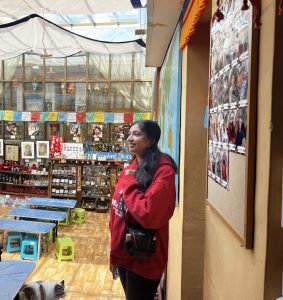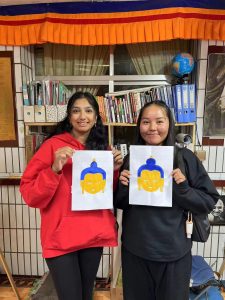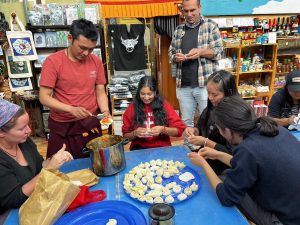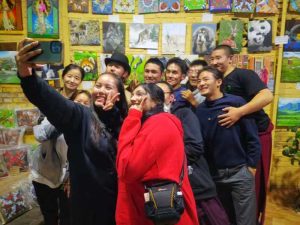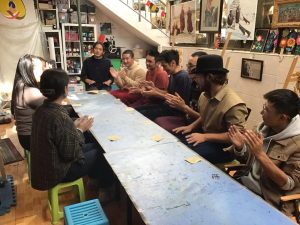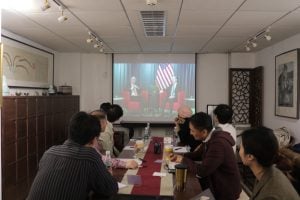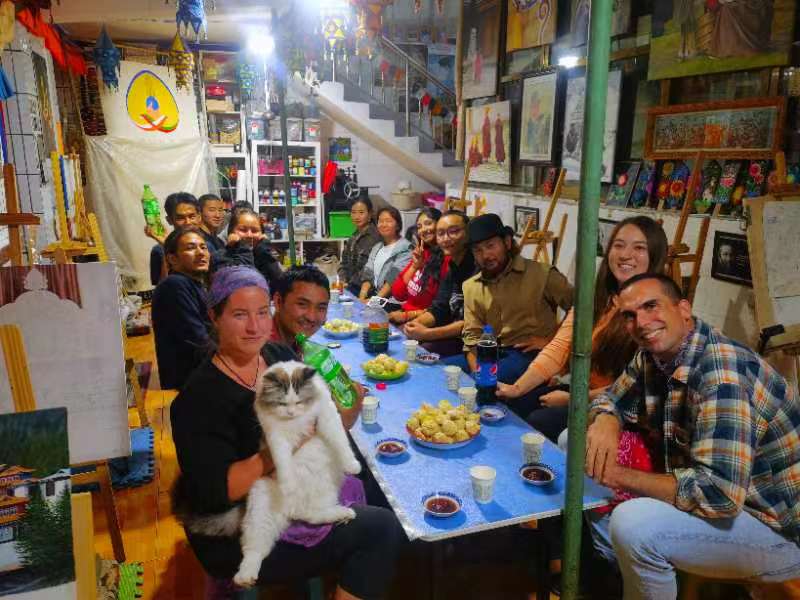
Artists Rock: Visiting an Art School on the Silk Road
Although we visited many locations while on the Silk Road Excursion, visiting Xiahe and the Snowland Arts school was definitely one of my favorite experiences. Located within walking distance of the famous Labrang Monastery, Snowland Arts is a small but beautiful school hosted in the home of Tenzin Dolma – the owner and sole teacher of the learning center. Standing outside the door I could sense a homely and welcoming energy. The sign outside reads, “Welcome to Snowland Arts” on a chalkboard sign next to a rock painted “Artists Rock.”. In the distance behind the school, you can see the Tibetan mountains making it a magnificent view.
Tenzin opened the door and welcomed us into her home. Covering all the walls are the magnificent works of her present and past students. They varied in content; landscapes, animals, objects, and people young and old. I recall assuming that some of the artwere photographs before walking close enough to see the intricate details painted on with each stroke. As Tenzin showed us a tour of her home we learned more about her students. Currently, the school houses 10 students who all live with their teacher for 5 years before graduating. Every day, they spend several hours focusing on their pieces, and typically receiving art lessons in the evening.
The unique curriculum emphasizes the importance of these main points: art history and influential artists, slowing down and taking your time, and intention. It was clear to us the great level of focus and self-discipline needed to carefully make each stroke on the canvas. A piece could take anywhere from a few months to several months to complete.
What was truly inspiring was the teacher’s emphasis on the intention of making art. Tenzin stressed that her students would not paint with the intention of making a profit. She emphasized her belief that art holds personal importance and value that cannot be monetized and passes it on to her students.
When the tour was done, we learned about the history of Thangka paintings in preparation to make our own pieces. We were led to an art room where students sat focused on their work and began working on our mini versions guided by Tenzin. I remember taking my time on my piece worried that my drawing of a Buddha’s head would look nothing like it. Reassuringly, Tenzin began telling us that this method of drawing the Buddha’s head is the same method used by Thangka artists from thousands of years ago. It has always been a foolproof way to make sure the drawing resembled a Buddha’s head no matter the artist’s level of experience.
When we moved on to the second step, painting, Tenzin explained that the pigments we use are from the same types of minerals used by the earliest Thangka painters. Some minerals are found in Tibetan regions, and some pigments- such as Lapis blue, can only be found in Afghanistan despite being a color found in artwork from all parts of the world. This thought was very fascinating to me. We sat in one place doing something as common as drawing and painting, yet we were connected, in a way, to regions all around us and artists from thousands of years ago. A sentiment I soon learned would be felt often as we explored the Silk Road.
After our paintings were done, we joined them for dinner – that is, we went to the market to buy ingredients and participated in making the Tibetan-style dumplings called momos. We quickly learned that making momos was no easy task – however, students were very patient and helpful in the process. One student spent the whole time redirecting Pasheen and I as we continuously struggled to fold the dough correctly to make a perfect momo. There was a lot of laughing and bonding over the dough. The best part was when we finally got used to making momos and began talking to each other- using Tenzin as a translator. We learned simple words like “hello” and “thank you” in Amdo. In return we attempted to teach them words in our native languages, Pasheen taught them “thank you” in Navajo and I did the same in Urdu. The rest of the time making momos was spent having fun with each other’s languages.
The night was not over yet. During dinner, we had a chance to get to know each of the students’ personalities and interests. While sitting at the long family-style table everyone spoke an array of languages. The students mostly conversed in their local Tibetan languages, some also spoke Chinese, and a lot of the students were keen on practicing their English with us. We got to listen to songs in their languages and showed some of our own as well. As someone who has never listened to Tibetan music, I was very interested in learning the names of songs so I could listen back on them. At one point in the night, the students started singing their favorite Hindi songs that I recognized having grown up listening to them. I found that they enjoy Indian films and that one of them enjoys singing “Bole Churdia” a Bollywood classic.
A Tibetan song they shared was a rap that one of the students rapped along to. I found it interesting how music, as an aspect of art, connects the world. Rap, a genre of music that originated in black communities in the US, has found its way to Tibetan communities. Likewise, the idea of art and music being universal languages was most evident here. I remember towards the end of the night thinking about how many languages were going on at the same time while Hindi, Tibetan, English, and French music played in the back.
In the end, our time in Labrang was very short. We TBC students hoped we could stay in one place longer, but we had other destinations along the Silk Road to also explore. On the second day, we visited the school again and taught each other games to play in large groups, since they had a big alumni reunion event coming up soon. We spent hours playing, messing up, making fools of ourselves, and laughing. It was amazing to see how playing games unleashed the childish and obnoxiously loud sides of all of us.
I remember while heading back to the hotel that night Pasheen and I set out to explore the town. While out, we talked about the people we just befriended, funny moments we shared with them, and their fun personalities. We discovered there was still much unsaid. That night we made sure to go to local shops to buy pens, stickers, and letters so we could write notes with what we had left to say to each one. The next morning, we visited the Snowland Arts School one last time and gave the students our notes before heading out to our next destination.
While in Labrang, my biggest regret is not knowing enough of their languages to communicate better with everybody. However, we bonded over shared interests, learned of everyone’s personalities while talking over dinner and playing games, and exchanged WeChats to stay in contact.
Nabeeha Misbah, Fall 2023 TBC Student



